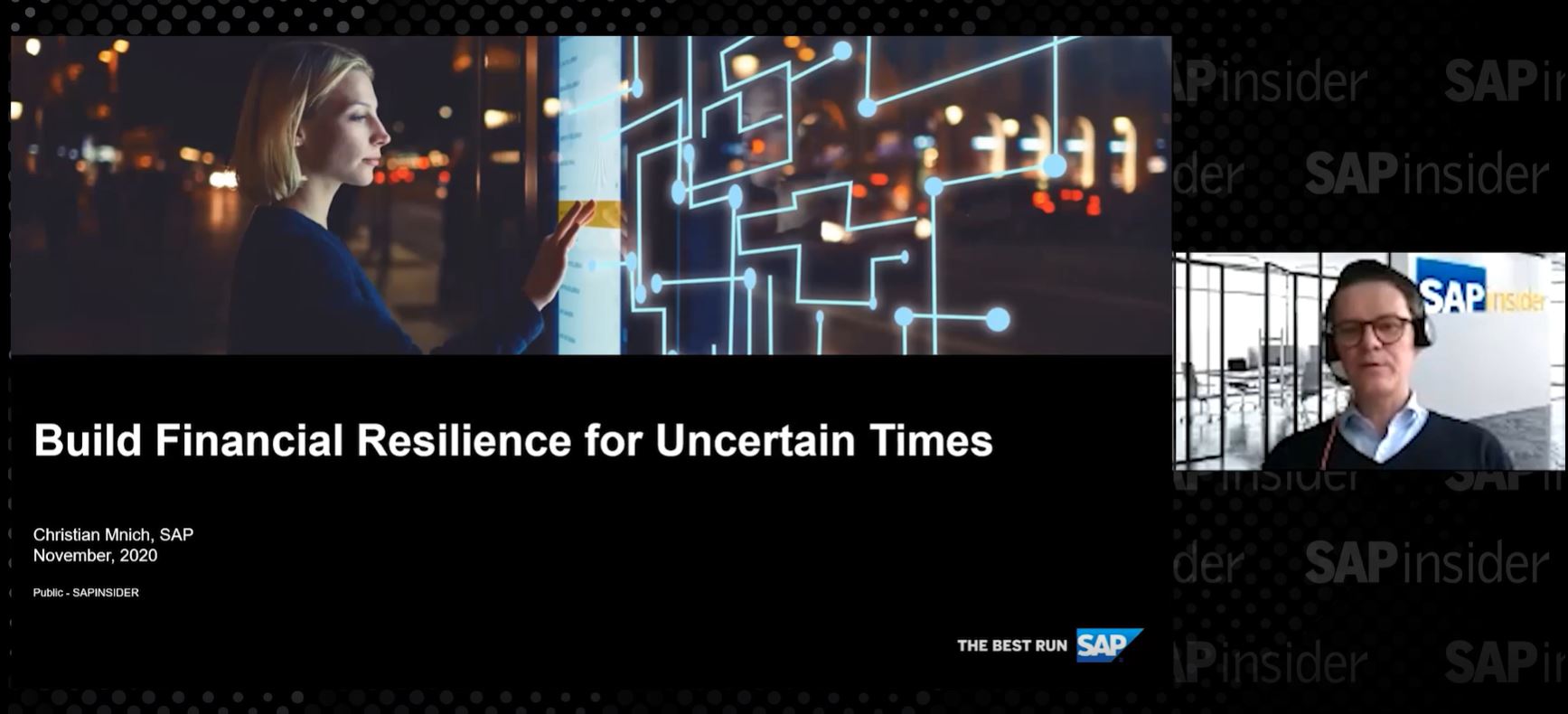Bob Stark Offers Key Lessons for Navigating Bank Industry Chaos
Meet the Authors
Key Takeaways
⇨ The recent collapse of Silicon Valley Bank and ongoing uncertainty is forcing SAPinsiders to evaluate the current and future state of finance and treasury operations
⇨ To gain insight on next steps for SAPinsider, we sat down with Bob Stark, Global Head of Market Strategy at Kyriba, to discuss how treasury teams can best prepare for uncertainty.
⇨ The Silicon Valley Bank's collapse can provide many lessons for organizations around enhancing business continuity, accelerating liquidity planning and management, and counter-party risk management.
The banking industry has been in chaos lately, thanks to the recent collapse of Silicon Valley Bank and ongoing uncertainty. This turbulence provides a stress test for the current finance and treasury operations of SAPinsider organizations, offering lessons across areas such as business continuity, liquidity planning and management, and counter-party risk management.
I recently had the chance to sit down with Bob Stark, Global Head of Market Strategy at Kyriba, to discuss his insights on how treasury teams can best prepare for these challenges. The conversation spanned many topics, so I will break it into three parts.
This first part of our conversation explores key lessons for treasury teams in light of the Silicon Valley Bank collapse and continued banking industry instability. The transcript covering that part of the discussion with Bob Stark is what follows:
Hey Bob, I appreciate you joining the call on such short notice given the current banking industry chaos and its impact on the companies you work with daily. It would be great if you could provide a little background regarding your role at Kyriba.
Bob Stark:
Sure. And thank you for the opportunity by the way. It’s always nice to have these conversations and ultimately help CFOs and treasurers become more resilient to all the fun things happening in the world today. In terms of my background, I’m the global head of market strategy at Kyriba, and my role is very simple. We try to help our clients and stakeholders, but I focus more on the client side to try and help them understand what’s going on in the world globally, what sort of, I guess, we’ll say news events, what opportunities we have to build our product around their emerging needs.
And so, whether it’s talking about potential bank meltdowns, whether it’s talking about economic volatility or currency headwinds, these are all areas that we look to provide a point of view for our clients, but also build capabilities in the platform to make them more resilient, to make them better manage their cash and liquidity. So that’s the short version, but hopefully, that’ll do for what we want to talk about today.
Ogo Nwanyanwu
You mentioned recent headlines regarding bank meltdowns. I imagine you are pretty busy based on the headlines of the day that continue to evolve seemingly hour by hour.
Bob Stark:
Yeah, it’s a funny thing. Yes and no in terms of being exceptionally busy as a result of that; the interesting part of this whole Silicon Valley Bank meltdown, for lack of a better word, was that when a bank, let’s say, evaporates, which effectively happened in terms of the sales and takeover by FDIC, et cetera, you expected discontinuity in operations. You expect from, let’s say, a financial standpoint to no longer have access to your simple bank reporting statements like what are my balances? What are my transactions? How much cash do I have at Silicon Valley Bank as an example, or signature or other ones that were affected? And similarly, can I send my payments?
And the interesting thing is that these capabilities were not interrupted. Some of our clients bank with Silicon Valley Bank, and their concern was what’s next, not what is happening now from a technology standpoint. And that’s interesting because you would have expected that everything taps are shut off, you don’t have visibility, and everything stops. And it wasn’t what happened. There were a lot of individuals that were able to extract a significant amount of cash out of Silicon Valley Bank. So the interesting part is not so much the dealing with that, although that was very stressful for organizations that had cash or liquidity or funding tied to Silicon Valley Bank. What lessons are we learning from this?
Ogo Nwanyanwu:
In terms of the lessons that CFOs and treasury teams can take regarding the banking industry chaos, from their response to this event to the resiliency of their technology, what would you say are your top lessons takeaways for CFOs and treasury teams?
Bob Stark:
That’s a tough one, but I’ll try my best here. Let’s look at the top three:
The number one lesson is business continuity. I need to be able to operate. If you’re an organization where SVB was your primary banking relationship, you’re probably utilizing them for supplier payments and other disbursements. You’re using them as the lifeblood of your business. And if you felt at some point during the day, and many customers did, that you no longer had access to that cash, even though that consequence didn’t really materialize, but if you felt that that was what was going to happen, then low and behold you’re going to feel like you have a business continuity problem. What am I going to do to run my business? How am I going to pay the bills? How am I going to be able to continue to operate and grow? So that’s the first lesson learned, and there’s a lot more to that. That’s the simple version.
The second lesson is what I would call liquidity planning and real-time liquidity planning. This concept of liquidity planning is fundamental to ensure that whatever is going to happen, whether it’s economic volatility, whether it’s commodity prices going up, whether it’s inflation, whether it’s FX, whether it’s interest rates jumping up again or it’s a bank having a meltdown, that you are in control of your cash and liquidity and ability to sustain your enterprise and your cash operations no matter what is happening. So the key thing the CFO looks at is what is our exposure.
The one point I’ll make regarding real-time liquidity planning, to go down a mild rabbit hole, but I think it’s an interesting one, is that if you have your liquidity planning and your cash forecasting is an example, if you’re doing that once a day, or maybe it’s every two days, but let’s just say once a day, you’re not able to react to a situation like this. This happened so fast that you needed instant visibility, instant access, and the ability to move money, and you needed to know in real time because the CFO, CEO, board, et cetera, was all asking questions around, “What’s our problem? What do we need to do?” You can’t have stale data and need to react like anyone on their phone can to be able to move money and mobilize cash. So the words real-time are just as important as obviously planning for liquidity and planning for risk scenarios. So that’s a second point, we’ll call it a learning opportunity.
The third lesson is about having control of your counterparty exposure, and that seems like a very uninteresting requirement or uninteresting lesson compared to many of the things we just talked about. But it’s really important because this was a wake-up call for many, and I suspect there are many organizations, in fact, I know of many organizations that are looking at their counterparty exposure reports or their bank counterparty exposure reports and identifying should we have seen this coming? And is there a way in the future that we can protect ourselves by having better data and better policies around where are cash, where our liquidity is held so that we’re making the right business decisions and being able to react maybe a little bit more proactively when we identify that perhaps a limit or a condition or some metric that we see as important to manage our overall cash and liquidity for the organization that one of those conditions is breached. So there’s a lot more depth to each of these areas, but I think those are the ones that are certainly the biggest lessons to be learned.
Ogo Nwanyanwu:
When I think about the SAPinsider finance community and findings from our research over the last six to 9 months, we see the demand for insights and visibility from finance and treasury teams consistently emerge as the number one driver of how organizations are strategically prioritizing investments into technology and automation, especially in areas like liquidity management, financial planning, cash forecasting, etc. Coming out of the pandemic, there was this desire to enhance these areas, but we see that some organizations still have to do more work.
Bob Stark:
That’s an interesting insight. Yes, they do.
[Editor’s note: End of the first part of the conversation that focuses on the key lessons. This interview has been edited and condensed.]
The events surrounding Silicon Valley Bank’s collapse present many challenges for organizations of all sizes. Still, there are lessons CFOs and treasury teams can internalize now to mitigate potential risks in the future. By leveraging the current uncertainty to identify and address any gaps or inefficiencies around business continuity, liquidity planning and management, and counter-party risk management, SAPinsider organizations can ensure they are prepared for potential disruptions to finance and treasury operations.
Technology partners, such as Kyriba, offer tools and services designed specifically for treasury teams so they can better understand their exposures and take steps to mitigate potential losses before they occur.
In the next post, we will explore how Bob Starks partners with SAP organizations to help enhance cash visibility with access to real-time information.
Make sure to download and read our AP Invoice Management Benchmark Report and our Cash Management and Cash Visibility Benchmark Report, available for all members of the SAPinsider Community/
Please take our Intelligent Finance in the Cloud survey to share your insights on intelligent automation and see where you stand against your peers.






